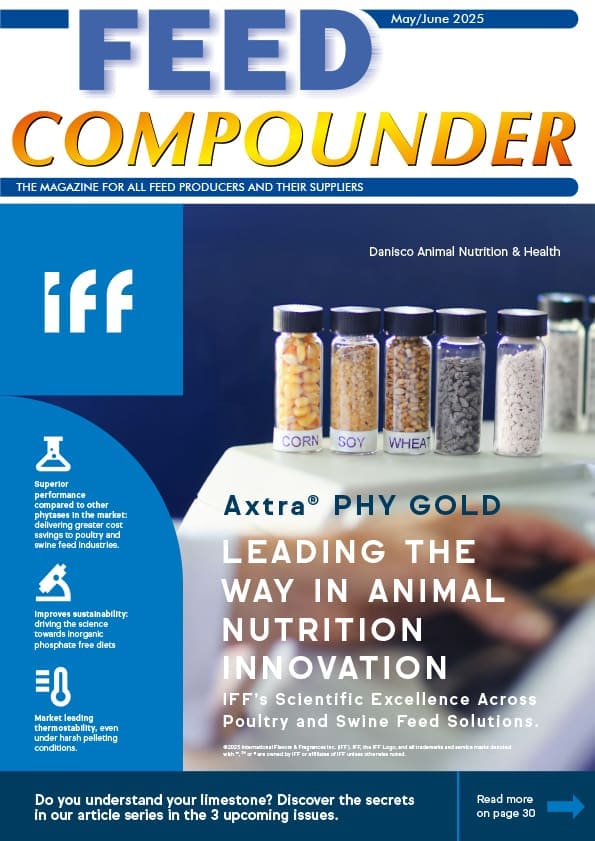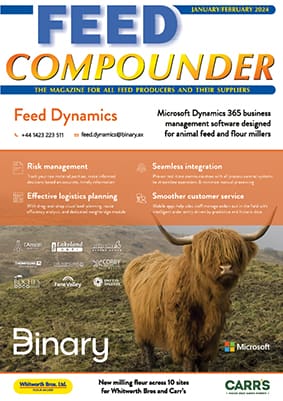UK dairy farmers looking to cut soya from rations to meet environmental targets and reduce costs could risk leaving cows short of essential amino acids — potentially hitting milk yields, fertility and cow health — warns independent nutritionist Andrew Jones from ChewintheCud Ltd.
While rumen-protected amino acids (RPAAs) are widely used across Europe and the USA, they are only just starting to gain traction in the UK. Mr Jones believes their popularity will increase as pressure mounts to reduce crude protein (CP) levels and lower emissions, and as farmers realise the production and health benefits they offer to cows.

Amino acids are the building blocks of protein, with 20 in total and 10 classed as essential because the cow cannot produce them, they need to either be fed, or supplemented, them.
Traditionally, UK dairy cow rations have aimed for 16–18% CP using ingredients like soya. However, much of this protein is broken down in the rumen and converted to microbial protein, which may not fully meet the cow’s amino acid needs.
“Crude protein is what it says, it is a crude measure of the protein content of the diet, which means it could be missing some of the essential amino acids, resulting in some of the body functions not working as optimally as they should be. Each feed will also have a different amino acid profile,” Andrew adds.
What are rumen-protected amino acids (RPAAs)?
RPAAs are designed to bypass the rumen and be absorbed directly in the small intestine, allowing nutritionists to target key amino acids more precisely.
“By supplying rumen-protected methionine and lysine, over time we can reduce overall CP in the ration and still maintain or improve milk yield and quality, and also cow health,” explains Mr Jones.
“Whilst on the face of it they may appear costly, farmers need to remember RPAAs are precision nutrition,” says Mr Jones. “In reality, only about 10–30g a head per day may be required, it will depend on your own diet’s requirements, and long term they allow you to reduce the overall crude protein in the diet, which can actually save money — alongside the health and fertility benefits.”
Methionine has long been known as the first limiting amino acid in most UK dairy diets. But as farmers look to reduce or replace soya, lysine — another essential amino acid — is also at risk of becoming limiting. Lysine is critical for milk protein synthesis, immune function and reproductive performance.
One of the barriers in the UK, Mr Jones believes, has been the prices of many rumen-protected amino acid products. However, he says farmers need to look beyond that, with only small amounts needing to be fed — meaning cost isn’t really a barrier.
Benefits
In UK trials using rumen-protected amino acids, Mr Jones has seen three days knocked off the days to conception — results that have since been replicated.
“The essential amino acids are involved in egg health, immune function and general cow health,” he says. “We’ve also seen less metritis and just healthier cows overall when RPAAs are included.”
Practicalities of feeding RPAAs
He adds that RPAAs don’t need to be fed throughout a cow’s life. Instead, he recommends targeting their use in the transition period — from 21 days pre-calving to 120 days post-calving. During this time of greatest nutritional demand and metabolic stress, responses are seen in milk yield, fat and protein, but also in fertility and health.
A meta-analysis reviewing 21 studies on the effects of rumen-protected methionine showed that while supplementation pre-calving had no effect on dry matter intake; after calving it increased dry matter intake, milk yield, milk fat yield and milk protein yield.
Milk fat percentage rose by +0.15% and milk protein by +0.66%. The response to methionine fell as lactation progressed, confirming that feeding it during transition and early lactation offers the greatest return.
“In cows it isn’t just about the milk in the tank,” stresses Mr Jones. “With rumen-protected amino acids it’s the health and fertility benefits that can really make the difference.”
Benefits have also been seen when rumen-protected amino acids are fed to calves, with improvements in growth, earlier age at first service and fewer cases of disease and mortality.
RPAAs come in all different forms and can be fed as a prill, in a premix, or added in a TMR. However, when selecting a product, Mr Jones says it is vital to choose a product that is truly rumen-protected and that is backed up by research.
“There are some products without the same level of protection, so be aware of what product you are using and work with your nutritionist to get the balance right.”
He also says that latest research is indicating that the ratio of methionine to lysine needs to be balanced at 2.65:1.
Mr Jones says that in the long term, feeding RPAAs will allow farmers to reduce the overall CP of the diet gradually. “You could start at around 16.5% CP, balance the amino acids accordingly, then drop crude protein by 0.5% at a time. There are herds maintaining production and health at 15% CP — and in the USA, some are down to 13.5% CP. Remember, cows don’t have a requirement for crude protein; their requirement is for amino acids.”
He also stresses the importance of testing forages regularly to understand their amino acid profile so that diets can be balanced accordingly.
German animal nutrition specialists BEWITAL agri has been doing a lot of work on rumen-protected amino acids and has recently launched a new BEWI-FATRIX® range distributed exclusively in the UK and Ireland by Azelis, a global innovation service provider in the speciality chemical and food ingredients industry. The BEWI-FATRIX® range uses special cryotechnology to protect essential amino acids like lysine and methionine from rumen degradation. This ensures targeted delivery to the small intestine, where they are most efficiently absorbed and utilised by the animal.
Independent research has consistently demonstrated high bioavailability of the BEWI-FATRIX® products thanks to the special production process, which embeds amino acids evenly to minimise degradation, rather than enclosing them in a conventional fat coat.
Trials by Schothorst Feed Research show that BEWI-FATRIX® Methionine 50 achieves a rumen stability of 88%, with 88% intestinal digestibility and a bioavailability of 77.4% under passage rate of 8 hours, offering a highly effective source of bioavailable methionine for dairy cows.
Azelis UK Ruminant and Equine technical sales manager, Leia Trotman adds:
“It’s important when looking at products that the RPAAs really do bypass the rumen — as it’s in the small intestine where they are then transported via the blood to the liver and processed for various metabolic functions, including the synthesis of body proteins, conversion to glucose, or storage as fat.
“Using RPAAs, such as the BEWI-FATRIX® range, helps support optimal milk protein synthesis, improving both milk yield and quality. The award-winning BEWI-FATRIX® LM 101 product has delivered impressive results in on farm trials, boosting milk performance by 2.3 kg/day and increasing milk fat synthesis by 80 g/day. By targeting the essential amino acids that cows actually require, producers can reduce overall crude protein in the diet without compromising performance — which also contributes to lower nitrogen excretion and environmental impact.”
The BEWI-FATRIX® range is easy to incorporate into premixes, minerals, or complete feeds, with all amino acids within the range embedded in a rumen-stable fat matrix derived from either palm oil or rapeseed oil (RS) for efficient bypass into the small intestine.
For further information please contact Leia Trotman at Azelis on: +44 (0)7792116659 or via email: leia.trotman@azelis.co.uk
Visit the Azelis website here: https://www.azelis.com/en



